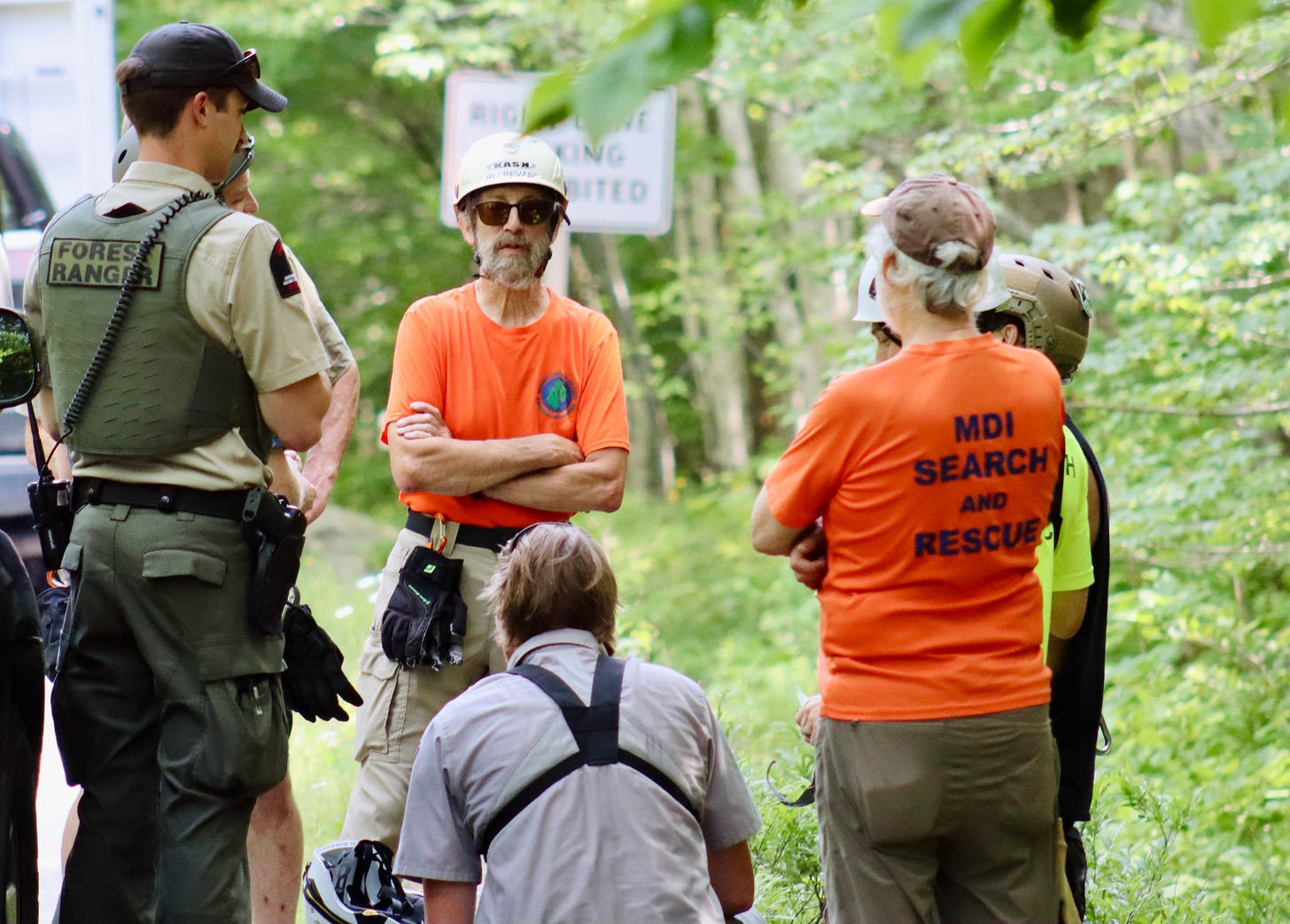When Seconds Matter: How a Climber’s Fall Met a Rare, Rapid Rescue.
He fell in front of "the perfect group to fall in front of."
The Bar Harbor Story is generously sponsored by The Links Pub.
BAR HARBOR—Sometimes an emergency rescue in Acadia National Park deviates from other rescues. Sometimes that difference has the potential, in a game of minutes where seconds count, to make a huge impact in the long-term outcomes of traumatic injuries.
One of those rescues that turned out to be a little different happened in the park on Monday.
According to Acadia National Park’s Management Assistant John Kelly, on June 23, a 20-year-old male fell approximately 20 feet at the South Wall of Champlain Mountain climbing area.
The park’s dispatch center received its initial call regarding this event, according to Kelly, at 1:57 p.m. The Bar Harbor ambulance was dispatched to the location and when the first park ranger arrived at approximately 2:16 p.m., according to scanner traffic, he advised all responding units to stand down because the patient was already at the ambulance.
In a world where rescues from trails (especially ones that have any difficulty or ones that attract climbers) usually require dozens of people and take hours to get the patient to the ambulance, this rescue took approximately 19 minutes.
The man had been climbing the South Wall of Champlain Mountain, a popular spot for climbing that is next to the Precipice Trail. If there can ever be a factor called luck in a potentially fatal accident, this young climber had it.
That’s because also at that location was a group of students participating in a class being given by a company called SASTAC. The class was a clinic on the topic of patient packaging and evacuation from exactly this type of setting. The students were current military, law enforcement, and civilian contractors: the kind of people you would expect to need the training and expertise to operate in such environments as a vertical cliff face.
SASTAC’s CEO, Micheal Ackerman explained Tuesday that the company was born out of another company, Silverton Avalanche School, of which Ackerman is the executive director.
Silverton is the country’s oldest operating snow and avalanche school and according to Ackerman, in 2013 the school started getting more requests from the military to come train in snow space. Just before the COVID pandemic, the demand was so great that they felt the need to take the tactical department out of the avalanche school and create another school. So, Ackerman and two other partners started SASTAC.
“The roots of this program, and lucky for that victim yesterday, the roots are rescue. That’s what this is all born out of,” Ackerman said.
Ackerman said the company has been training this course for three years and while real life rescues have popped up for the company’s classes in Colorado (which is the company’s home base) this is a first for a class at Acadia National Park.
“So these guys are in the middle of a two-week training where we are really drilling down on this stuff and right next to them, this is not a scenario,” Ackerman said.
“Unfortunately for the person yesterday, they have some healing to do ahead of them,” Ackerman said, “For us, what an incredible training opportunity!”
Ackerman was not in Maine the day of the incident but was glad that his instructors and class members were present and were able to put their skills to work in the real world and help this fall victim in the most expedient manner possible.
And that is what they train for.
“What we really drill down on is the ICS system (incident command system), so it’s how do you bring disparate parts (together) and have some sort of multi-agency collaboration working within the greater incident command system? That includes everything from task force level straight on through to incident commander, safety officer, who is fetching pizza, and everything on the food chain in between” Ackerman said. “The extra weight of SOPs (standard operating procedures) and ICS in the civilian world can really slow down a response.”
“Slow is smooth, smooth is fast, but fast is f***ing fast!” Ackerman said. “That’s what we are actually doing.”

He added of their ability to help on Monday, “We were happy to have the opportunity. We don’t want any accolades or commendations for this. It was just one part of a much bigger day.”
And they were prepared for it.
During these classes, in whichever environment they are training in, they have an emergency action plan (EAP). Correspondingly, they have all of the equipment necessary to carry out that EAP if something unexpected should happen during the training. Since this particular class was focused on patient packaging and evacuation from exactly this type of setting they were well equipped to perform the necessary rescue.
The park service wanted to be clear, that the fall did not take place on the Precipice Trail and was outside of the Peregrine closure area. None of the climbing groups were in a closed area.
In relation to training in the park, Michael Ackerman said, “SASTAC is fully permitted and insured with the park. They drill down on us pretty hard to be able to do this.”
Due to HIPAA restrictions, the Bar Harbor Story has no update on the climber who fell.
LINKS TO LEARN MORE
National Incident Management System
Follow us on Facebook. And as a reminder, you can easily view all our past stories and press releases here.
If you’d like to donate to help support us, you can, but no pressure! Just click here (about how you can give) or here (a direct link), which is the same as the button below.
If you’d like to sponsor the Bar Harbor Story, you can! Learn more here.










Thank goodness for the fast response of the rescue crews. We are so lucky in Acadia and so is that young man. Phew!